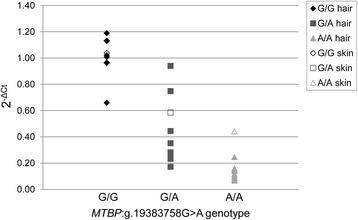Whole genome sequencing identifies missense mutation in MTBP in Shar-Pei affected with Autoinflammatory Disease (SPAID)
- PMID: 28472921
- PMCID: PMC5418765
- DOI: 10.1186/s12864-017-3737-z
Whole genome sequencing identifies missense mutation in MTBP in Shar-Pei affected with Autoinflammatory Disease (SPAID)
Abstract
Background: Autoinflammatory diseases in dogs are characterized by complex disease processes with varying clinical signs. In Shar-Pei, signs of inflammation including fever and arthritis are known to be related with a breed-specific predisposition for Shar-Pei Autoinflammatory Disease (SPAID).
Results: Clinical and histopathological examinations of two severely SPAID-affected Shar-Pei revealed signs of inflammation including fever, arthritis, and perivascular and diffuse dermatitis in both dogs. A multifocal accumulation of amyloid in different organs was found in one SPAID-affected case. Whole genome sequencing resulted in 37 variants, which were homozygous mutant private mutations in SPAID-affected Shar-Pei. Nine SNVs with predicted damaging effects and three INDELs were further investigated in 102 Shar-Pei affected with SPAID, 62 unaffected Shar-Pei and 162 controls from 11 different dog breeds. The results showed the missense variant MTBP:g.19383758G > A in MTBP to be highly associated with SPAID in Shar-Pei. In the region of this gene a large ROH (runs of homozygosity) region could be detected exclusively in the two investigated SPAID-affected Shar-Pei compared to control dog breeds. No further SPAID-associated variant with predicted high or moderate effects could be found in genes identified in ROH regions. This MTBP variant was predicted to affect the MDN2-binding protein domain and consequently promote proinflammatory reactions. In the investigated group of Shar-Pei older than six years all dogs with the mutant genotype A/A were SPAID-affected whereas SPAID-unaffected dogs harbored the homozygous wildtype (G/G). Shar-Pei with a heterozygous genotype (G/A) were shown to have a 2.13-fold higher risk for disease development, which gave evidence for an incomplete dominant mode of inheritance.
Conclusions: The results of this study give strong evidence for a variant in MTBP related with proinflammatory processes via MTBP-MDM2 pathway. Thus, these results enable a reliable detection of SPAID in Shar-Pei dogs.
Keywords: Autoinflammatory disease; MTBP; Shar-Pei; Whole genome sequencing.
Figures





References
-
- Saunders CJ, Miller NA, Soden SE, Dinwiddie DL, Noll A, Alnadi NA, Andraws N, Patterson ML, Krivohlavek LA, Fellis J, Humphray S, Saffrey P, Kingsbury Z, Weir JC, Betley J, Grocock RJ, Margulies EH, Farrow EG, Artman M, Safina NP, Petrikin JE, Hall KP, Kingsmore SF. Rapid whole-genome sequencing for genetic disease diagnosis in neonatal intensive care units. Sci Transl Med. 2012;4(154):154ra135. doi: 10.1126/scitranslmed.3004041. - DOI - PMC - PubMed
Publication types
MeSH terms
Substances
LinkOut - more resources
Full Text Sources
Other Literature Sources
Research Materials

